by Bill Palmer 2017
This article is written to mark the 30th anniversary of Movement Shiatsu, an approach to physical therapy that I developed in the 1980’s which is particularly relevant to working with so-called disability, chronic conditions and old age. Many people would say that it bares little resemblance to the common forms of Shiatsu. It seems closer to Feldenkrais Method [[1]]or Body-Mind Centering [[2]] because it integrates body-awareness exercises, movement experiments and bodywork into a coherent system. In this approach the client is more active and the practitioner facilitates the client’s self-exploration rather than treating them as a passive recipient.
However, I see it as an evolution of Shiatsu for two reasons. Firstly, the theory underlying Movement Shiatsu includes many of the ideas common to other forms of Shiatsu. In fact, as we shall see, it actually explains them in terms that modern scientific culture could accept as plausible hypotheses.
Secondly, the many forms of Shiatsu have a wide variety of theories and techniques but most of them use a common quality of touch. This vertical, non-manipulative and still touch gives the client a sense that the practitioner is listening to them at a profound level and stimulates self-awareness. Movement Shiatsu uses the same quality of touch and also helps the client to use their awareness to explore themselves and experiment with their habitual patterns.
In this article, I will tell the story of the development of Movement Shiatsu and explain how working with children with special needs taught me the basic principles that underlie this work.
Combining Movement and Shiatsu
In 1979 I started working at the Central School of Speech and Drama teaching video techniques. It also turned out to be a big step in my parallel life as a therapist. The drama students often hurt themselves in movement classes and, once word got around that I was good at helping people recover, my office turned into a very busy part time clinic. Subsequently, these same students asked me to start teaching them how to prevent injury so I started teaching what I called Shiatsu and Movement classes.
The main focus of these classes was how to become aware where the flow of movement through the body was interrupted or inhibited. Such a break in the smooth continuity of connection in the body produces an area that is vulnerable to injury. The Shiatsu used touch and guided movement to explore how to bring this discontinuity together.
Movement Development and Personality
One of my other jobs at Central was to make videos of the treatments done by the Speech Therapists for teaching purposes. Several of the staff in the speech therapy department also came to my Shiatsu and Movement classes. One of them was Kay Coombes, a specialist in working with children with disability. Kay and I developed a close working relationship. While I was making videos of her work, I would be asking questions, making suggestions and learning the basics of the Bobarth style of developmental physiotherapy that was her expertise [[3]].
I found a deep empathy with these children and attended several advanced training courses in neurological and developmental therapies to learn how to work with them myself. I started to develop a theory of how the different ways that a child developed movement skills affected their patterns of movement and posture in later life. Bonnie Bainbridge Cohen, who was exploring similar ideas in her system of Body-Mind Centering, also felt that sensory feedback from these patterns influenced the development of personality [2].
To give a simple example, if a child for some reason does not learn to move forward easily they may end up with a feeling that self-motivation is difficult. This could lead to a personality that is demanding and over-dependent on others. But I am not sure this is necessarily a causal relationship. Babies who have difficulty crawling often find other ways of moving themselves and it could be that the over-dependence on others is an innate characteristic that pre-disposes them to ask for help rather than trying other ways to move themselves.
Over a period of ten years, I documented the development of six of the major infantile movement abilities in a cohort of children and gathered some evidence that a baby’s way of developing movement seemed to be correlated with the development of certain character traits as they grew older.
It was impossible to tell whether the style of movement caused the character trait or whether their character predisposed them to favour certain types of movement. In fact, I think it is a two-way relationship; that body patterns and emotional patterns are two aspects of the same phenomenon. It is obvious how different postures express personality but it is also true that changing one’s posture results in a different experience of self.
What is Qi?
I think that this inter-relationship between body and mind is the real meaning of what Chinese medicine calls Qi. This is often translated as ‘Energy’ but that gives the impression that there is some substance that flows through the body driving the functionality of the organism. I prefer to see it as a description of similarities between certain bodily and mental processes that hints that these processes are co-created.
Traditional Chinese medicine describes several different forms of Qi that can be seen as fundamental functions that apply to both mind and body. For instance, the ability to satisfy need and the ability to push out things that you don’t want are an essential ingredient of autonomy both emotionally and physically. The process of eating, digesting and excreting is a physical example of this abstract function but it is obvious that these capacities are also part of emotional intelligence. In Chinese Medicine this particular function is called the YangMing [[4]].
Maybe our experience of our body and our mind are just different perceptions of the same thing. It is therapeutically useful to view the types of Qi as abstractions about this deeper reality because one can see how it might be possible to work physically with an issue that is perceived to be emotional, or vice versa.
Babies explain Meridians
However, an aspect of Chinese medicine that I found it difficult to swallow was the idea of meridians, the ‘channels’ along which Qi was said to ‘flow’. For reasons that I have explained in other articles [[5]] I found the interpretation of Qi as a form of energy not described by science deeply implausible. And if Qi is an emergent property of the complexity of body and mind then it didn’t need channels to flow in. In my opinion there is no satisfying explanation in East Asian tradition of why these exact lines are related to the different forms of Qi.
A possible explanation occurred to me while I was documenting the step-by-step development of certain whole body movements such as pushing away from the ground, rolling and crawling. These developmental movements don’t appear all at once, they spread through the body progressively bringing muscles and fascia into collaboration until the full movement is achieved. Surprisingly, the track along which they developed exactly followed the traditional meridians.
Significantly, the character trait that seemed to develop alongside the movement matched the description of the Qi related to the associated meridian. So this seemed to be a potential explanation of the traditional concept: that meridians are innate lines through the body, or innate connectivity in the motor cortex, showing how to connect parts of the body to perform these archetypal movements. Through this process, babies develop mentally as well as physically and the common theme in the particular body-mind skill that they learn is called the Qi of the meridian.
Disability is Personal Ability
Thus one can see ‘problematic’ musculo-skeletal patterns as attempts to solve developmental challenges rather than problems to be fixed. Efficient development is not automatic, it depends largely on environmental stimulation and facilitation. At a certain stage, a baby wants to move forward and if crawling is too awkward she finds another method such as ‘bum-shuffling’. It may not be the most efficient or the most ‘normal’ way of moving. But it is her way!
This is especially true of babies with disabilities such as cerebral palsy (CP). In this condition, it’s not the environment that inhibits efficient development but the damage to the brain interrupting the learning of certain movements. But, the way the baby learns to move is her ability not her disability. It is only seen as disability if you have a rigid idea of normality.
Whatever the cause of patterns, they help to form the person’s sense of self. If the therapy tries to undo abnormal patterns and focuses too much on developing ‘normal’ movement, then it can create a deeper sense of being disabled along with feelings of shame and frustration – simply because the patterns that exist are the child’s sense of self and the intention to change them gives them the message that they, basically, are not OK.
Start by Exploring Ability
To a young child, how they are is all they know. The act of comparison with others and the discovery that one is not ‘normal’ is something that only slowly develops after the age of four [[6]]. So it is vitally important that therapy with young children supports their sense of ability rather than trying to change the abnormal patterns. Then the young child has a basic feeling of being whole as they are and this provides a good platform for facing later challenges.
Working with young children with cerebral palsy taught me practical ways of doing this. Instead of starting with the problematic areas, I find a movement that is easy. I praise it and suggest to the child that she does it more and bigger! For instance, if she can open her hand, I sing a song, opening and closing my hands along with the tune and get her to copy me. This initial success is enormously important for the spirit. We then go on to see what other opening movements she can do. Can she open her eyes, her mouth, her arms. If we come up with a difficult area, we can start working with it – she knows what she wants to do and has the positive spirit to experiment. My bodywork is simply helping her to do what she wants rather than forcing her to do something that she feels she can’t do.
I now think that this applies to everyone. If the client and their therapist both focus on the problematic issues then the client is more likely to feel disabled and to remain a victim to their problems needing rescue by the therapist. On the other hand, if the therapy starts by finding where the client’s ABILITY lies then the client’s spirit is strengthened by capability and he is empowered to start exploring himself, even challenging his own patterns, rather than asking to be fixed and rescued by the therapist.
Experiments with Movement
It’s relatively easy to experiment with and explore your movement patterns and postural habits. In my experience, this is often all that is needed to start a process of change in both body and mind. You do not need an idea of an ‘ideal’ posture or the right way to move. All that is necessary is to loosen the domination of the pattern by experimentation and then the organism has the freedom to find new and possibly better ways of doing things.
I find that this is most effective when the client learns how to play with particular muscles. Large, multi-muscle movements are confusing to work with but single muscles are open to change. To give an example, if you find a chronically tense muscle that resists stretching then, if you consciously tighten it further, you are simply doing more of what is happening anyway and so the muscle doesn’t resist. By doing this, you have moved the control of the muscle from the unconscious to the conscious and this opens the door to wider exploration.
Three Pillars of Movement Shiatsu
This discussion illustrates the three fundamentals of Movement Shiatsu based round the central core statement: ” What you are is your ABILITY not your DISABILITY”
Exploring oneself and experimenting with ingrained patterns can be hard work and not to everybody’s taste. The self naturally resists change, even good change. Many people come to a body therapist explicitly to be treated. They don’t want to explore, to experiment and to do work on themselves. This is a totally valid contract but, for some people, being treated is not enough. Movement Shiatsu provides tools for helping a client to do work on themselves through the body, if that is what they want. In my experience there are three groups of people who especially benefit from these tools:
1) People who would be classified as disabled. This classification is insulting to the spirit and the change of viewpoint that Movement Shiatsu gives can validate the person and help them to see their way of being as their success rather than their failure.
2) People with chronic issues, both physical and emotional. Typically, a person with long term physical issues has been to many therapists and tried out many types of therapy without success. This litany of therapeutic failure is depressing and maintains them in a position of being a victim to their condition. Movement Shiatsu changes the goalposts so they no longer see their condition as something to be cured but as a stimulus to deeper awareness. Often the awareness and the explorations it leads to produce a change in the symptoms because the person is starting to be kind to themselves, but that is not the main goal.
3) Old Age, As we age our area of ability changes and it is common for people to lose confidence in themselves because they are comparing themselves with their capacities at a younger age. However, if one keeps exploring one’s current areas of ability, one often finds new capacities developing in older age that one’s younger self could not achieve. This means that your self-image might change but your self-valuation does not diminish.
Life as a Course of Lessons
In the last few decades a culture has developed where therapies are largely judged by how successful they are at fixing problems. But, then the only option for people whose issues cannot be fixed is ‘condition management’, which is a way of giving up hope and, when hope leaves, the life spirit often goes too.
Life can be seen as a series of challenges and lessons to be learned by meeting those challenges. Getting rid of someone’s problems for them might also take away the course material for their lessons. If one can help the client to become an explorer, seeing their disabled movements as successful abilities and helping them to see their difficulties as lessons then I feel that means that the therapy is strengthening the spirit as well as giving the best chance for deep change at the physical and emotional levels.
Dedication:
This article is dedicated to my friend Joanna and her daughter Fae. Joanna taught me, through the way she died from cancer, that a successful life is nothing to do with being healthy but depends on meeting its challenges with spirit, love and grace. Fae, though people would perceive her as severely disabled through cerebral palsy, is one of my strongest teachers, showing that seeking normality is crazy in a “world run by maniacs” (in the words of John Lennon) and that a person can be whole, able and beautiful however different they may be.
[1] Moshe Feldenkrais – Awareness Through Movement 1972
[2] Bonnie Bainbridge-Cohen: Sensing Feeling and Action. Contact Press. 1990
[3] Muller_Busch: Die Therapie des Facio-Oralen Trakts nach Kay Coombes 2015
[4] Bill Palmer – The Six Divisions – Journal of Shiatsu and Oriental Body Therapy 1994 Issue 5
[5] Bill Palmer – What is Qi: Journal of Shiatsu and Oriental Body Therapy. 1996 Issue 8
[6] LaRue Allen and Bridget B. Kelly: Transforming the Workforce for Children Birth Through Age 8: A Unifying Foundation 2015

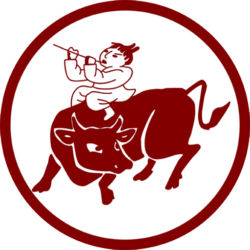
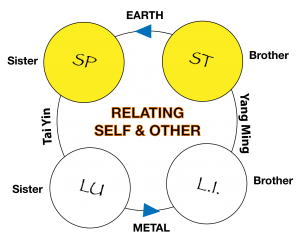
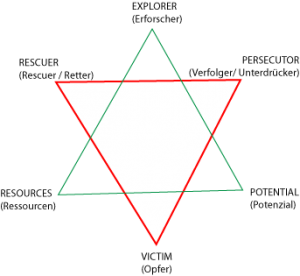
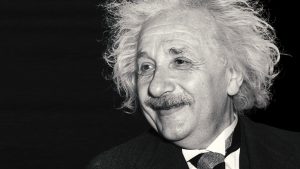 I have also said that according to Einstein, this is the reality- that the force of gravity is in some way an illusion and that what we really perceive is the way in which the floor stops us from moving down.
I have also said that according to Einstein, this is the reality- that the force of gravity is in some way an illusion and that what we really perceive is the way in which the floor stops us from moving down.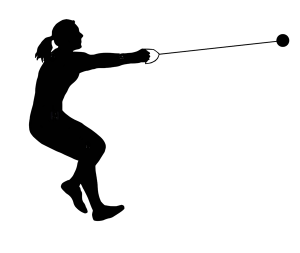 A very good analogy is swinging a ball on a chain:
A very good analogy is swinging a ball on a chain: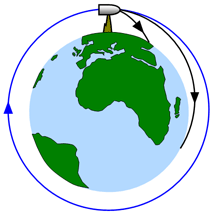 Newton’s cannonball
Newton’s cannonball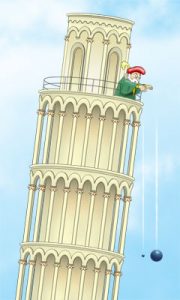 Galileo and the Tower of Pisa
Galileo and the Tower of Pisa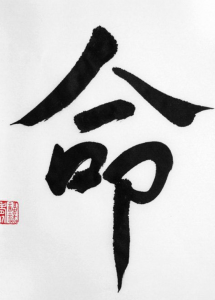 Taking the character for Ming to bits: the top two strokes represent a person. Then there is a single line – representing unity – and with a subtle connotation of unifying past and present, ancestors and oneself. Then two shapes. The left shape is a mouth and the right is an embryo.
Taking the character for Ming to bits: the top two strokes represent a person. Then there is a single line – representing unity – and with a subtle connotation of unifying past and present, ancestors and oneself. Then two shapes. The left shape is a mouth and the right is an embryo.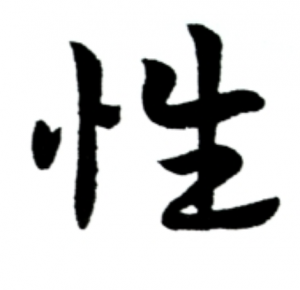 The second character Xing consists of two parts. The left is a heart, the right is life. So it means Heart-Life. It is normally translated as one’s nature.
The second character Xing consists of two parts. The left is a heart, the right is life. So it means Heart-Life. It is normally translated as one’s nature.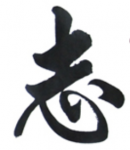 The Zhi
The Zhi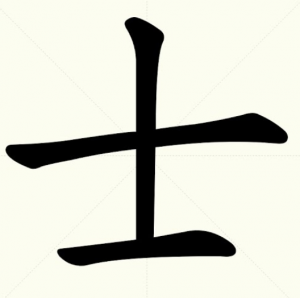
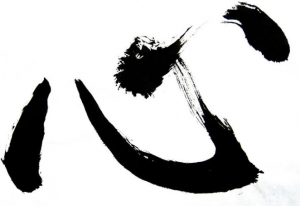 The bottom part is Xin, literally the Heart, but in Chinese it also connotes any aspect of Mind or Awareness. So together Zhi has the connotation of the Creative Mind. The aspect of ourselves that goes into new territory, doesn’t follow the herd but follows one’s authentic spirit.
The bottom part is Xin, literally the Heart, but in Chinese it also connotes any aspect of Mind or Awareness. So together Zhi has the connotation of the Creative Mind. The aspect of ourselves that goes into new territory, doesn’t follow the herd but follows one’s authentic spirit.